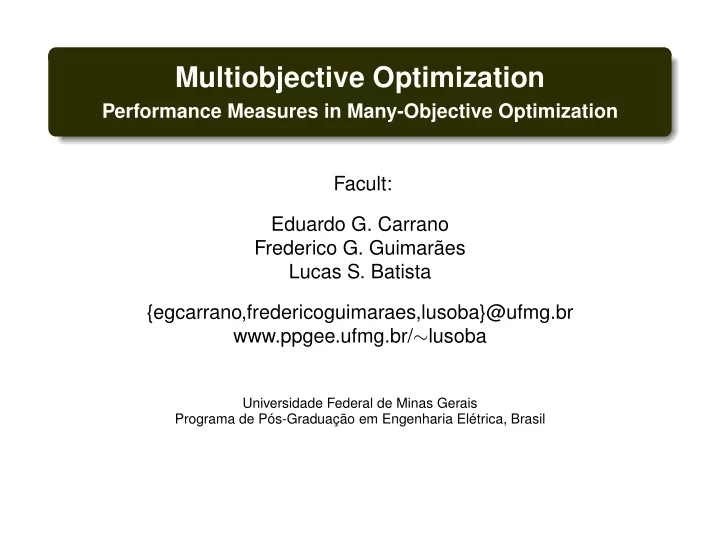

Multiobjective Optimization Performance Measures in Many-Objective Optimization Facult: Eduardo G. Carrano Frederico G. Guimarães Lucas S. Batista {egcarrano,fredericoguimaraes,lusoba}@ufmg.br www.ppgee.ufmg.br/ ∼ lusoba Universidade Federal de Minas Gerais Programa de Pós-Graduação em Engenharia Elétrica, Brasil
Performance Measures in MaO References Drawbacks of existing quality indicators for MaOPs Content Performance Measures in MaO 1 Drawbacks of existing quality indicators for MaOPs 2 / 12
Performance Measures in MaO References Drawbacks of existing quality indicators for MaOPs Many-objective optimization problem Multiobjective optimization problem in which m > 3. x f ( x ) ∈ R m , x ∈ F min f : X ⊂ R n �→ Y ⊂ R m g i ( x ) ≤ 0 ; i = 1 , . . . , p F = h j ( x ) = 0 ; j = 1 , . . . , q x ∈ X 3 / 12
Performance Measures in MaO References Drawbacks of existing quality indicators for MaOPs Existing Performance Measures for MaEAs Performance indicators can be broadly divided into five different categories according to the optimization goals, which involve me- asuring: the number of Pareto optimal solutions in the set; the closeness of the solutions to the theoretical true Pareto front; the distribution of the solutions; the spread of the solutions; both closeness and diversity at the same time. 4 / 12
Performance Measures in MaO References Drawbacks of existing quality indicators for MaOPs Existing Performance Measures for MaEAs 1st category: number of Pareto optimal solutions in the set ratio of nondominated individuals (RNI): measures the proportion of the nondominated solutions found with respect to the population size; error ratio (ER): checks the proportion of nontrue Pareto points in the approximate front over the population size; overall nondominated vector generation: counts the number of dis- tinct nondominated individuals found; n-ary performance metric: measures the ratio of nondominated so- lutions contributed by a particular approximate front to the nondomi- nated solutions provided collectively by all approximate fronts. 5 / 12
Performance Measures in MaO References Drawbacks of existing quality indicators for MaOPs Existing Performance Measures for MaEAs 2nd category: closeness of the solutions to the theoretical true Pareto front generational distance (GD): measures how far the evolved solution set is from the true Pareto front; inverted GD (IGD): concerns how well is the Pareto-optimal front represented by the obtained solution set; maximum Pareto front error: focuses on the largest distance between the individual in the theoretical Pareto front and the points in the ap- proximation front. 6 / 12
Performance Measures in MaO References Drawbacks of existing quality indicators for MaOPs Existing Performance Measures for MaEAs 3rd category: distribution of the solutions uniform distribution: quantifies the distribution of an approximate front under a predefined parameter; spacing: measures how evenly the evolved solutions distribute them- selves; number of distinct choices: identifies solutions that are sufficiently distinct for a predefined parameter. 7 / 12
Performance Measures in MaO References Drawbacks of existing quality indicators for MaOPs Existing Performance Measures for MaEAs 4th category: spread of the solutions maximum spread (MS): measures how well the true Pareto front is covered by the approximation set. 8 / 12
Performance Measures in MaO References Drawbacks of existing quality indicators for MaOPs Existing Performance Measures for MaEAs 5th category: both closeness and diversity at the same time hyperarea and ratio (or S-metric): calculate the volume covered by the approximate front with respect to a properly chosen reference point. 9 / 12
Performance Measures in MaO References Drawbacks of existing quality indicators for MaOPs Drawbacks In high-dimensional objective spaces, these metrics cannot per- form as well as in the low-dimensional spaces. Spacing: in a high-dimensional space, it is difficult to identify the closest neighbor due to a large objective space, requiring a heavier computation workload. IGD: suffers from the same difficulty. S-metric: can measure both convergence and diversity performan- ces in low-dimensional spaces, but in high-dimensional MaOPs, the calculated volume cannot reflect the distribution of the approximate Pareto front very well. 10 / 12
Performance Measures in MaO References Drawbacks of existing quality indicators for MaOPs Drawbacks In high-dimensional objective spaces, these metrics cannot per- form as well as in the low-dimensional spaces. MS: it may indicate a better quality for the nonconverged approxi- mate than for the converged but not well spread front in an MaOP . RNI: cannot provide much useful evaluation result in MaOPs since, in a high-dimensional space, nearly all individuals are nondomina- ted with respect to each other. 11 / 12
Performance Measures in MaO References References Zhenan He and Gary G. Yen, Visualization and Performance Metric in Many- Objective Optimization, IEEE TEC, v. 20, no. 3, p. 386–402, 2016. Inicio 12 / 12
Recommend
More recommend